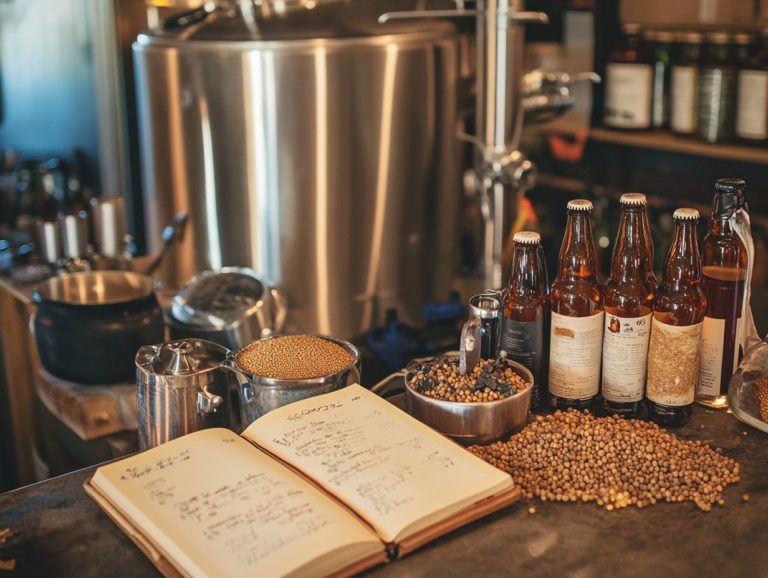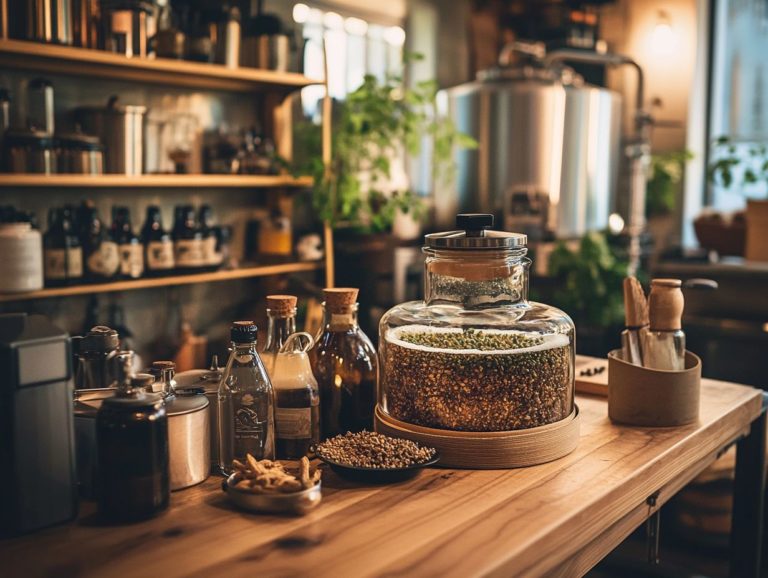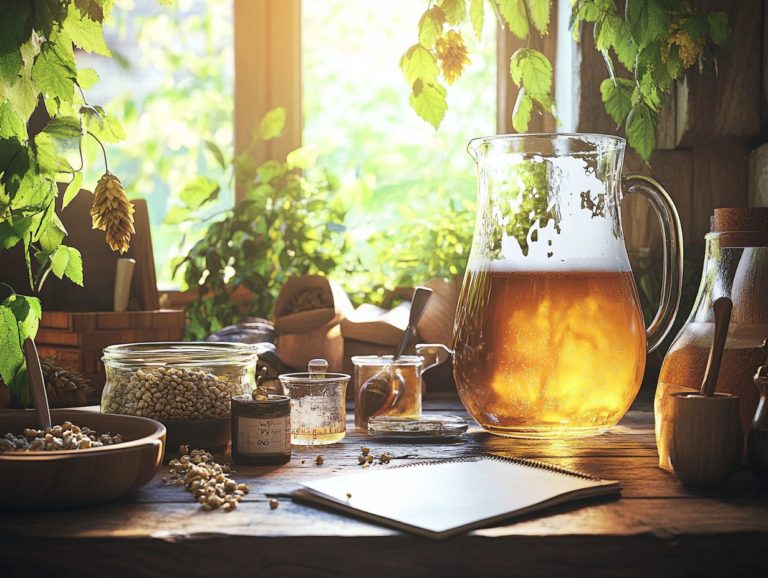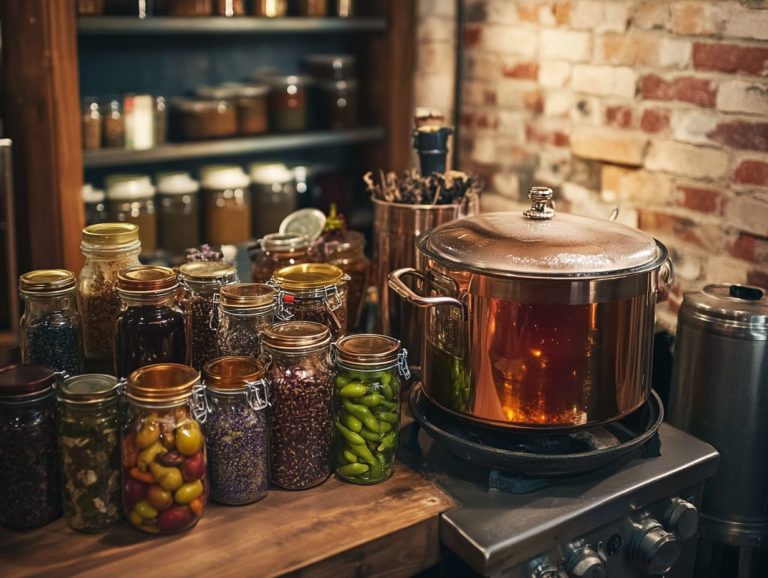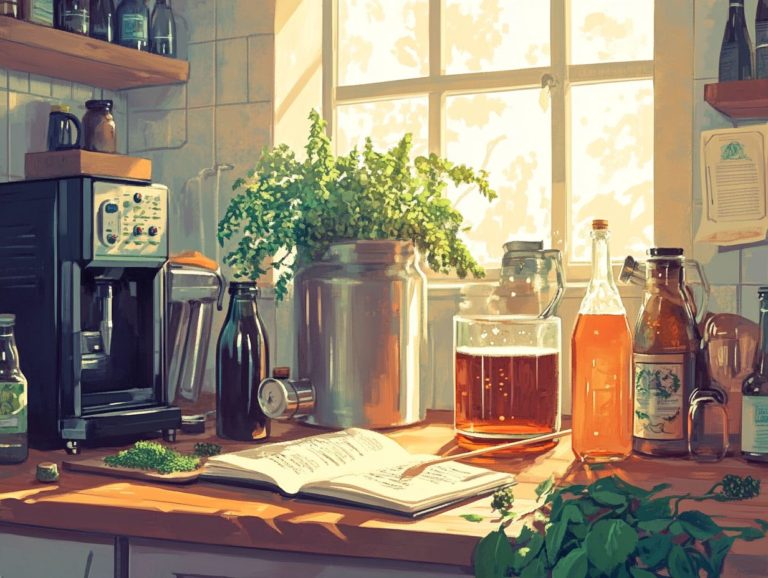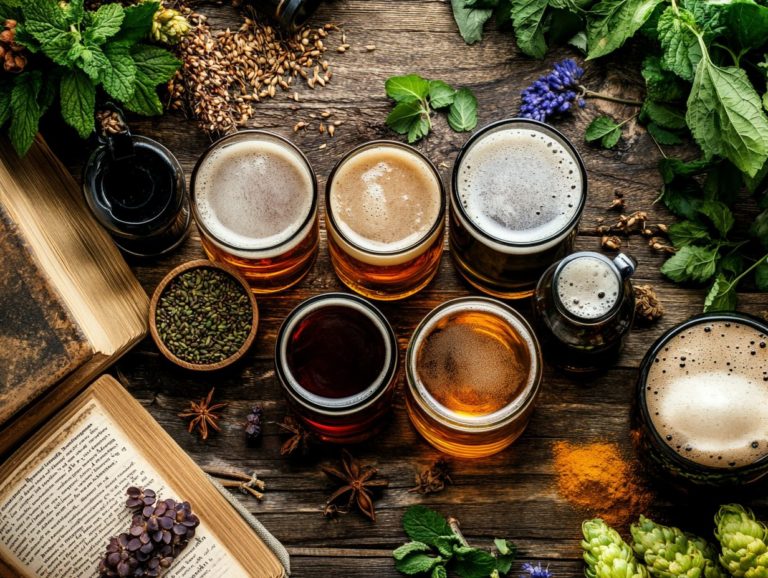Tasty Lager Recipes for Home Brewers
If you’re a home brewer, get ready to embark on an exciting brewing adventure! This article presents a curated selection of delectable lager recipes, ranging from the crisp and refreshing Classic German Pilsner to the rich and flavorful Czech Dark Lager, and even a robust Doppelbock.
It also tackles common brewing challenges that may surface, such as off-flavors, cloudy beer, and low carbonation. You ll find valuable tips to enhance your brewing skills and understanding of brewing equipment.
Prepare to impress your friends and family with your newfound lager-making expertise!
Contents
- Key Takeaways:
- Tasty Lager Recipes for Home Brewers
- Troubleshooting Common Issues in Lager Brewing
- Brewing Tips for Perfecting Your Lager Brewing Skills
- Frequently Asked Lager Brewing Questions
- What is a Lager Beer?
- What Are Some Popular Lager Styles?
- Are There Any Special Considerations When Brewing Lagers at Home?
- Do I Need Any Specific Ingredients for Lager Brewing?
- Can I Still Make Tasty Lager Recipes Without Expensive Equipment?
- Are There Any Tips for Beginners Looking to Brew Lagers at Home?
Key Takeaways:
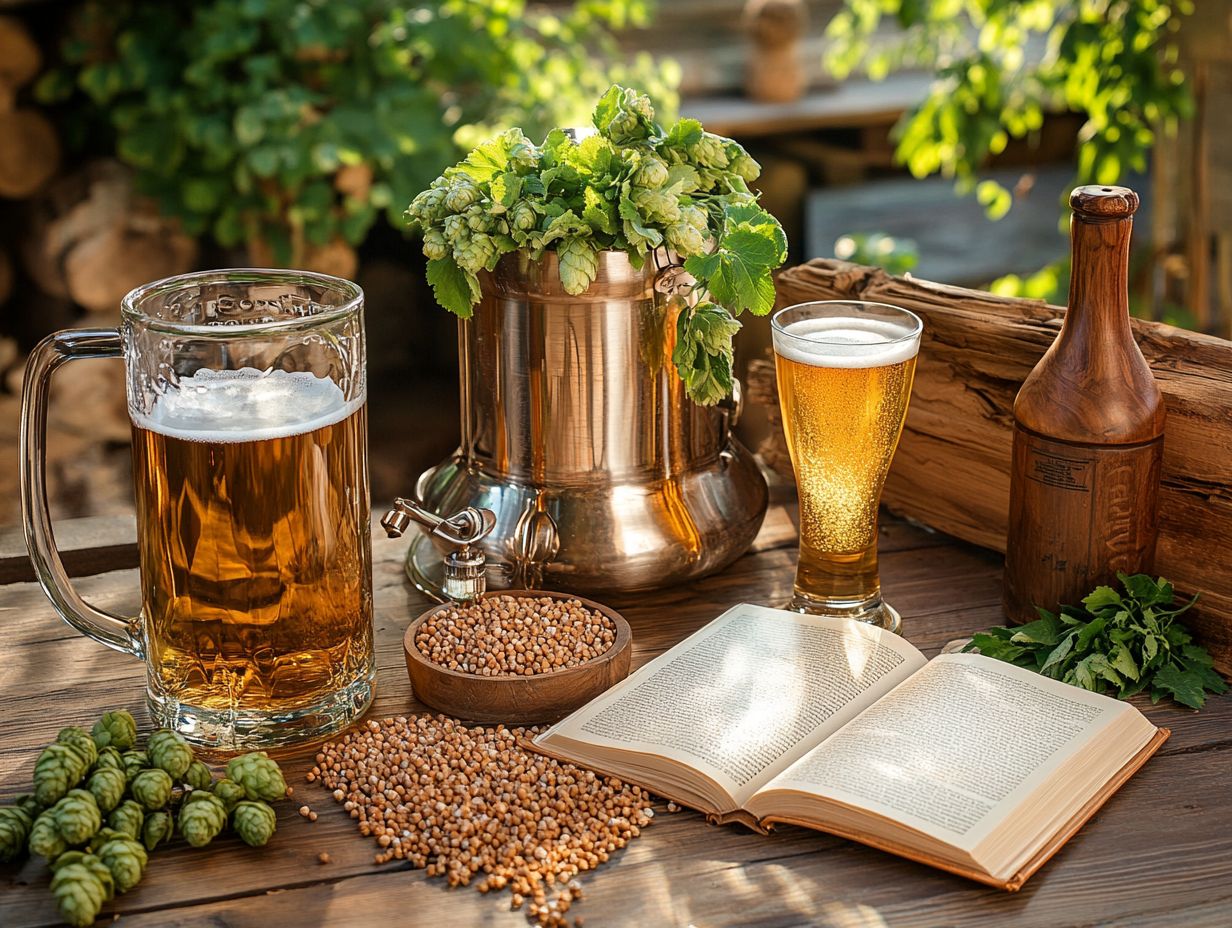
- Explore the world of lagers with these 5 tasty recipes, including classic pilsners, American lagers, and unique styles like Belgian witbiers.
- Learn how to troubleshoot common issues in lager brewing, from off-flavors to infections, and understand the importance of employing cold fermentation techniques to ensure your beer turns out perfectly.
- Take your lager brewing skills to the next level with tips for perfecting your technique, such as proper temperature control and yeast selection.
Tasty Lager Recipes for Home Brewers
Homebrewing is an exhilarating and rewarding journey for any beer enthusiast, particularly when crafting delightful lagers. With an array of recipes at your fingertips, from the timeless German Pilsner to the distinctive American lager, you have the freedom to experiment with various ingredients like malt, hops, and yeast to create your desired flavors and characteristics.
Brewing a Bohemian Pilsener or a Honey Lager can also add exciting variations to your repertoire. The brewing process involves crucial steps such as controlling fermentation temperatures and proper lagering the process of storing beer at low temperatures to improve flavor which are vital for producing beers with a crisp finish and well-balanced bitterness.
Attention to carbonation levels and selecting the appropriate hops variety are also essential for achieving the perfect flavor profile. Here are some delectable lager recipes that cater to both novice brewers and seasoned experts alike.
1. Classic German Pilsner
The Classic German Pilsner is a quintessential lager that captures the essence of traditional brewing. It is marked by its light body, crisp finish, and inviting floral hop notes. Breweries like Gordon Biersch and Victory Brewing Co. have perfected this style over the years.
To craft this iconic beer, you typically begin with a base of pale malt, often opting for Pilsner malt to achieve that pale color and slightly sweet flavor. A hint of Munich malt elevates the malt complexity. Your choice of hops is crucial; noble varieties like Saaz hops or Hallertau bestow that signature delicate bitterness and aromatic profile that make this style so beloved.
Fermentation is equally vital, generally taking place at cooler temperatures around 50-55 F to encourage a clean, refreshing taste. Proper conditioning before serving is key to reaching that perfect expression.
For those embarking on the homebrewing journey, focus on a well-controlled fermentation environment. Experimenting with carbonation levels can help you discover the ideal balance that showcases the subtle characteristics of this classic style. Consulting brewing tips from established breweries like Victory Brewing Co. and Gordon Biersch can provide valuable insights.
2. American Amber Lager
American Amber Lager presents a delightful harmony of malt sweetness and hop bitterness, making it a beloved choice for craft beer enthusiasts.
This captivating style typically features a blend of pale and caramel malts, offering rich, toasty flavors complemented by a subtle caramel character that lingers beautifully on your palate.
In terms of hops, you ll often find varieties such as Cascade or Centennial, which introduce floral and citrus notes, enhancing the overall flavor profile without overshadowing the malt backbone.
The fermentation process is key to crafting this exceptional beverage, with moderate yeast strains playing a vital role in achieving the perfect alcohol content, usually ranging from 4.5% to 6%. By meticulously controlling fermentation temperatures, brewers ensure optimal carbonation levels, delivering a smooth and refreshing drinking experience that is sure to appeal to your discerning tastes.
Start brewing today and share your tasty creations with fellow beer lovers!
3. Czech Dark Lager
Czech Dark Lager, with its rich malty sweetness and inviting dark color, presents itself as a distinctive gem within the lager family.
This exceptional brew is typically crafted from a blend of Munich and Caramunich malts, which bestow a deep caramel hue along with a hint of chocolatey richness. The brewing process often employs a decoction mash, enhancing the malt character and resulting in a wonderfully full-bodied texture. Fermentation usually takes place at slightly cooler temperatures than other lagers, creating a smooth and clean finish that doesn t overshadow the delicate sweetness.
Classic Saaz hops are thoughtfully integrated, imparting a gentle earthy bitterness that elegantly balances the maltiness and enriches the overall flavor profile. This makes the experience of enjoying Czech Dark Lager truly delightful for any discerning beer enthusiast.
4. Mexican-style Lager
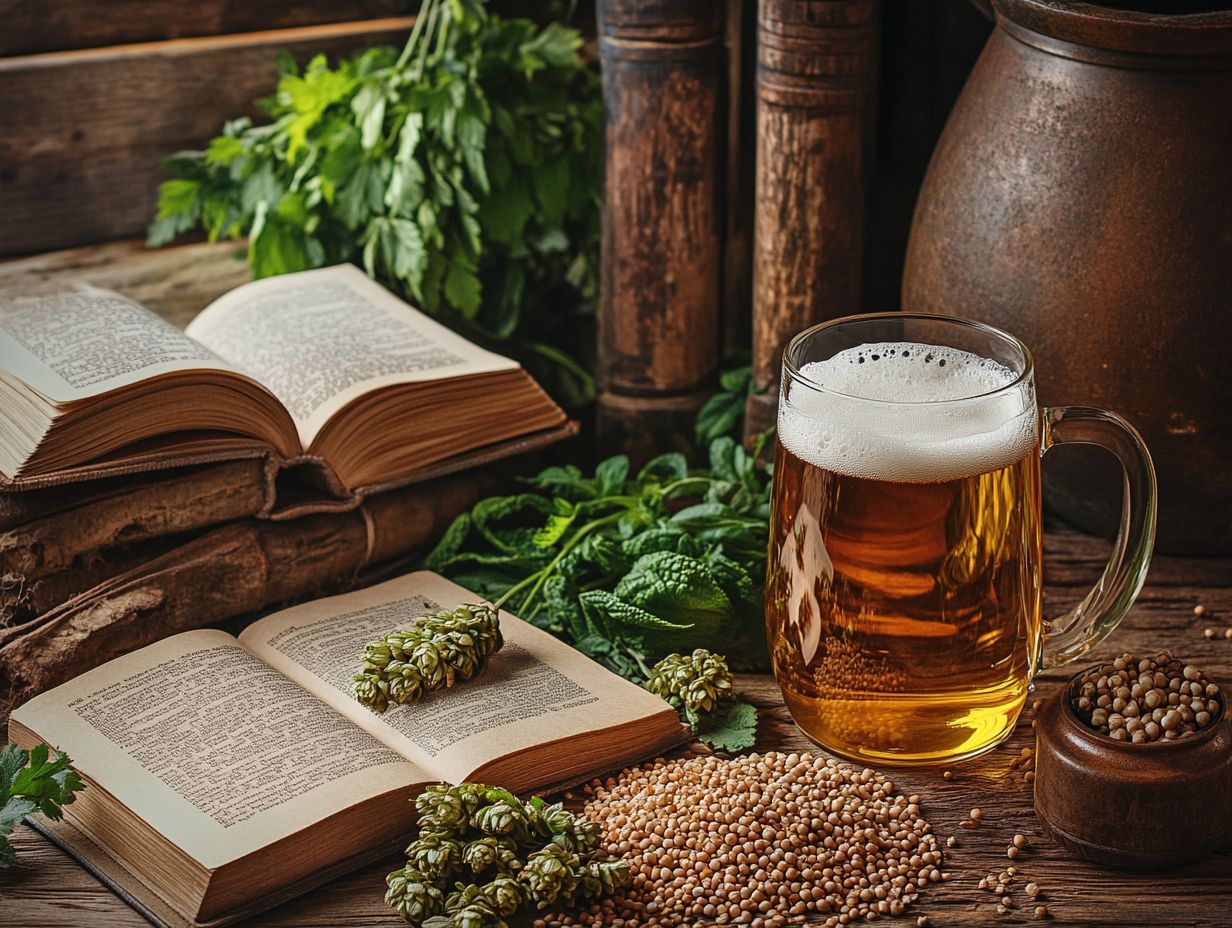
Mexican-style Lager is celebrated for its light, crisp, and refreshing qualities, making it a go-to choice for warm weather. This delightful brew often incorporates adjuncts like corn or rice, which enhance its smooth finish while keeping the body wonderfully light.
During the brewing process, these adjuncts contribute not only a characteristic sweetness but also improve drinkability, resulting in that signature refreshing experience you crave on a hot day. If you’re interested in homebrewing, achieving the perfect carbonation levels is essential; it adds to the overall mouthfeel and brightness of the lager.
By aiming for moderate carbonation, you can accentuate the beer s crispness without overpowering its delicate flavors, allowing for a truly enjoyable taste adventure.
5. Belgian Witbier
Belgian Witbier is a remarkable brew that, while classified as a wheat beer, masterfully incorporates lager principles to deliver a unique and refreshing experience, complete with herbal notes and a whisper of honey. This style has been embraced by many homebrewers and is often enjoyed during festive seasons like Oktoberfest.
This distinctive style typically boasts a grain bill where wheat makes up about 50%, contributing to its signature hazy appearance and smooth mouthfeel that you can’t help but enjoy. The choice of yeast is paramount, playing an essential role in crafting the beer’s complex flavors, which include delightful fruity and spicy notes that elevate your overall drinking experience.
To enhance its profile even further, brewers often introduce adjuncts like honey, which not only adds a layer of complexity but also reinforces the crisp finish that defines this delightful beer. The careful balance of these elements results in a refreshing beverage that embodies a light yet vibrant character, making each sip a true pleasure.
Troubleshooting Common Issues in Lager Brewing
Brewing lager can be an immensely rewarding endeavor, yet it presents its own unique set of challenges. You may encounter common issues like off-flavors, cloudy beer, low carbonation, and the dreaded risk of infection, all of which can compromise the quality of your final product.
Recognizing these potential pitfalls is essential for any homebrewer aiming to create lagers that align with their lofty expectations. By pinpointing the causes and applying effective solutions, you can refine your brewing skills and elevate your lager-making process to new heights. Learning from established breweries like Victory Brewing Co. and Gordon Biersch can also provide invaluable insights.
1. Off-flavors
Off-flavors in lager can be a frustrating hurdle for you as a homebrewer, often stemming from fermentation temperature issues or improper yeast management. These unwanted tastes can significantly compromise the overall quality of your brew. Common offenders include diacetyl, which brings a buttery flavor to the table, and acetaldehyde, often likened to the taste of green apples.
Such problems typically crop up due to temperature fluctuations during fermentation, which can agitate the yeast and result in these undesirable compounds. To tackle these challenges, it’s essential to maintain a consistent fermentation temperature within the yeast’s ideal range and to manage the pitch rate meticulously, ensuring a robust yeast population.
Opting for high-quality ingredients can elevate your final product. Allowing ample time for lagering will help achieve that clean, crisp taste synonymous with expertly crafted lagers.
2. Cloudy Beer
Cloudy beer is a common challenge in lager brewing, often caused by yeast and protein suspensions that fail to settle properly during fermentation. Cloudiness can happen for a few reasons, including improper fermentation temperatures that hinder the yeast s ability to clump together well.
The yeast strain you choose is crucial; some strains are more prone to producing haze due to their unique characteristics or how they interact with the proteins in your wort. Selecting appropriate lager yeast can make a difference. To achieve a clearer final product, consider implementing various techniques, such as using proper filtration methods to eliminate suspended particles and employing lagering techniques, which involve cold storage to let sediment settle.
By tackling these issues, you can craft a smoother, more visually appealing beer that truly impresses.
3. Low Carbonation
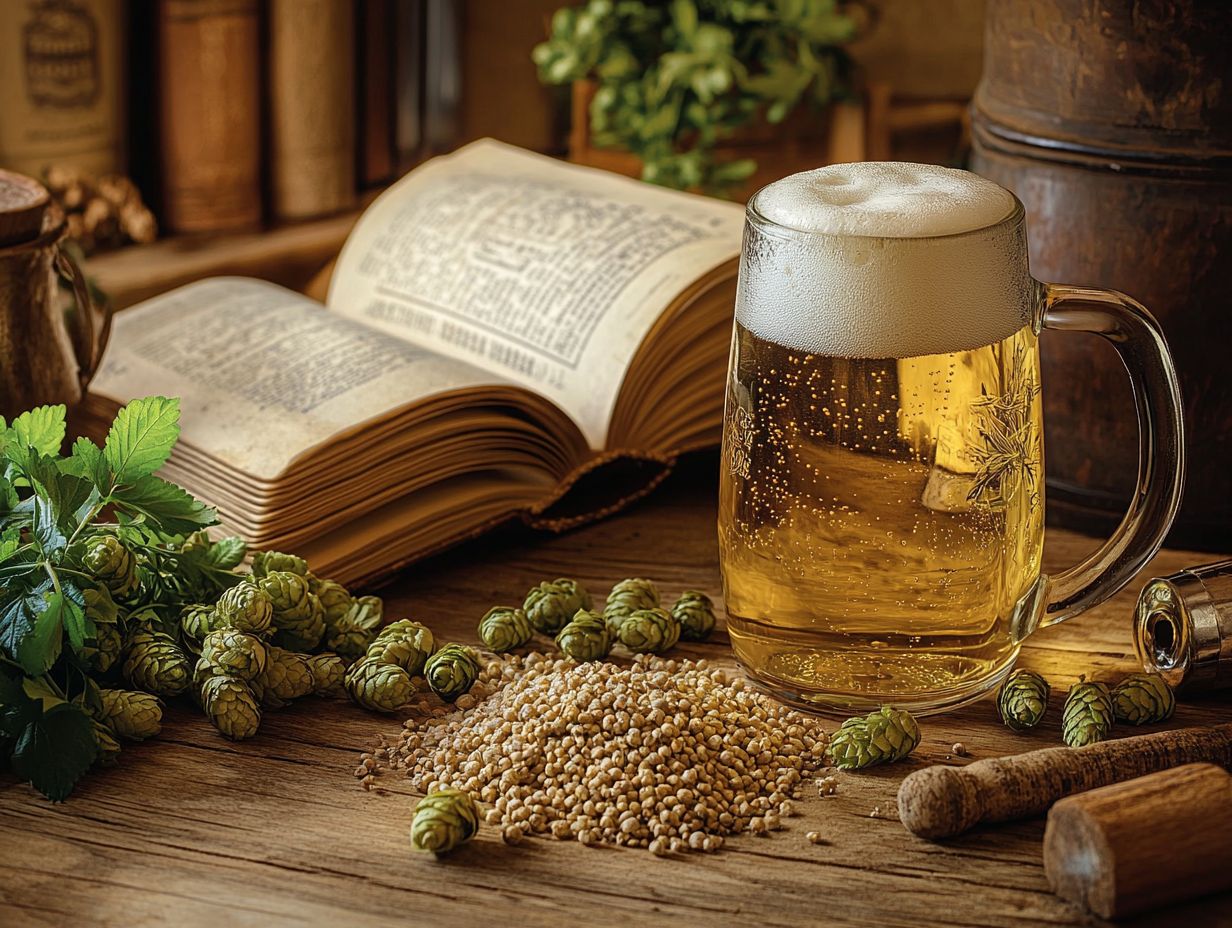
Low carbonation can ruin your enjoyment of a lager, often leading to flat mouthfeel and diminished aromas. It often results from insufficient fermentation or improper bottling practices. Monitoring your brewing process and adjusting your ingredients can help achieve the desired carbonation levels.
When those bubbles are missing, you might find that the mouthfeel is flat, the aroma is diminished, and the flavor complexity isn’t quite what it should be taking away from the intended pleasure of the brew. It s essential to identify the root causes of low carbonation; perhaps the priming sugar was not measured accurately, leading to inadequate carbonation during bottling, or fermentation issues could have caused the yeast to lose its vigor. Proper carbonation levels are critical for a beer’s overall flavor and mouthfeel.
To fix these issues, consider conducting a thorough evaluation of your brewing process. Ensure that you re using the right amounts of priming sugar and allow for additional fermentation time. These adjustments can significantly enhance carbonation levels and elevate your drinking experience, whether you re brewing a crisp Pilsner or a malty doppelbock, before you take that first sip.
4. Infection in Beer Brewing
Infection during the brewing process can be a brewer’s worst nightmare, especially when it comes to lagers like an American Lager or a traditional Bohemian Pilsener. This usually happens due to poor sanitation practices and potential contamination.
These infections can take on various forms, with wild yeast strains and bacteria being the usual suspects. The consequences can be dire, resulting in off-flavors and unpleasant aromas that are far from the crisp, clean profile you aim for. You might notice unwelcome signs like sourness, a slick mouthfeel, or strange aromas that stray from your lager s intended character. Using adjuncts like honey in a honey lager can sometimes mask minor infection signs, but it won’t solve the underlying issue.
To minimize these risks, it’s essential to adopt stringent sanitation protocols at every phase, from cleaning your equipment to handling ingredients. Emphasizing cleanliness helps prevent contamination, protecting the integrity of your batches and ensuring that only the freshest, most delightful lagers make it to your consumers. This is especially crucial for maintaining the characteristic crisp finish and floral notes of a well-brewed lager.
Brewing Tips for Perfecting Your Lager Brewing Skills
Perfecting your lager brewing skills demands a harmonious blend of knowledge, practice, and meticulous attention to detail. You’ll want to focus particularly on fermentation techniques and the careful selection of the right brewing equipment for the best results.
Understanding the importance of fermentation temperature and the use of lager yeast strains will make a significant difference in your final product.
Frequently Asked Lager Brewing Questions
What is a Lager Beer?
A lager beer is a type of beer that is fermented and stored at low temperatures for an extended period of time. This process results in a crisp, smooth, and clean-tasting beer with a light and refreshing flavor. It often involves cold fermentation techniques, which help achieve the desired profile.
What Are Some Popular Lager Styles?
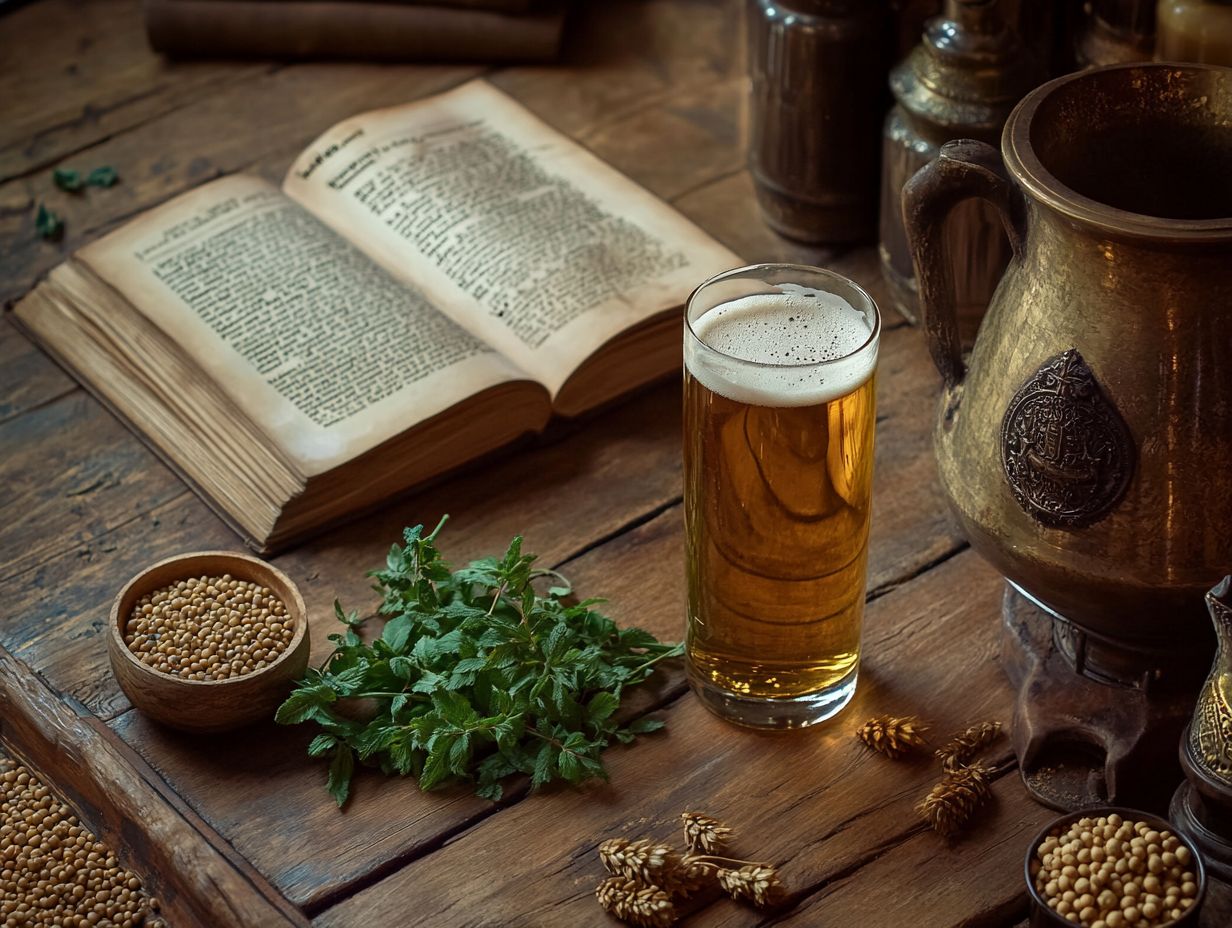
Some popular lager styles include Pilsner, M rzen, Helles, Bock, and Dunkel. Each style has its own unique flavor and characteristics. For instance, a German Pilsner is known for its bitterness and crisp finish, while a Dunkel offers a more malty sweetness.
Are There Any Special Considerations When Brewing Lagers at Home?
Yes, lagers require colder temperatures for fermentation. Therefore, it is important to have a dedicated space or equipment for temperature control. It is also recommended to use a lager yeast strain and have a longer fermentation and conditioning time compared to ales.
Using the right hops variety is also important. For example, choosing Saaz hops for a Czech Pilsener can significantly impact the flavor profile of your lager.
Do I Need Any Specific Ingredients for Lager Brewing?
While there are specific ingredients commonly used in lager brewing, such as Pilsner malt and noble hops, you can experiment with different ingredients to create your own unique lager recipes. Just make sure to maintain a balance of flavors and follow proper brewing techniques.
Some homebrewers also incorporate adjuncts like honey or different hops varieties to add unique characteristics to their lagers.
Can I Still Make Tasty Lager Recipes Without Expensive Equipment?
Absolutely! While temperature control is important, there are ways to achieve it without expensive equipment. You can ferment in a cool basement or use a DIY cooler for temperature control.
With some creativity and experimentation, you can brew delicious lagers at home without breaking the bank. Many successful homebrewers have created award-winning lagers with basic setups!
Are There Any Tips for Beginners Looking to Brew Lagers at Home?
Start with a simple lager recipe and familiarize yourself with the process and techniques. Patience is key when brewing lagers, so take your time and don’t rush the fermentation and conditioning process.
Don’t be afraid to ask for advice from experienced home brewers or join a local home brewing club for support and guidance. Consider trying a Dark American Lager or a Phil s Lager as your first few recipes to get a good feel for the process.
Now, it’s your turn! Dive into the art of lager brewing and share your experiences with fellow enthusiasts!

